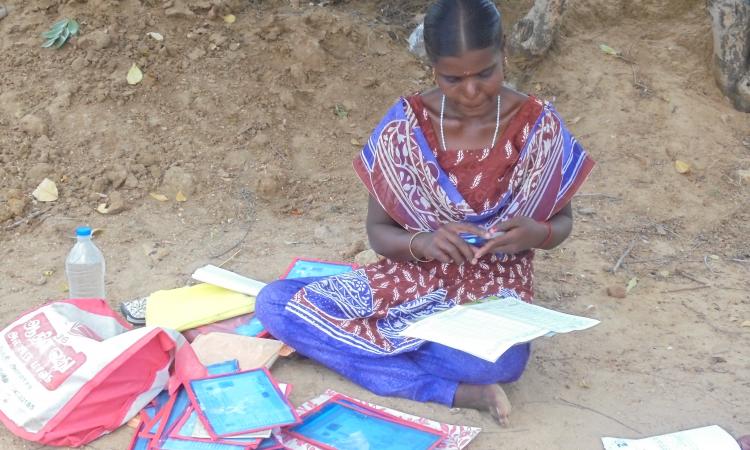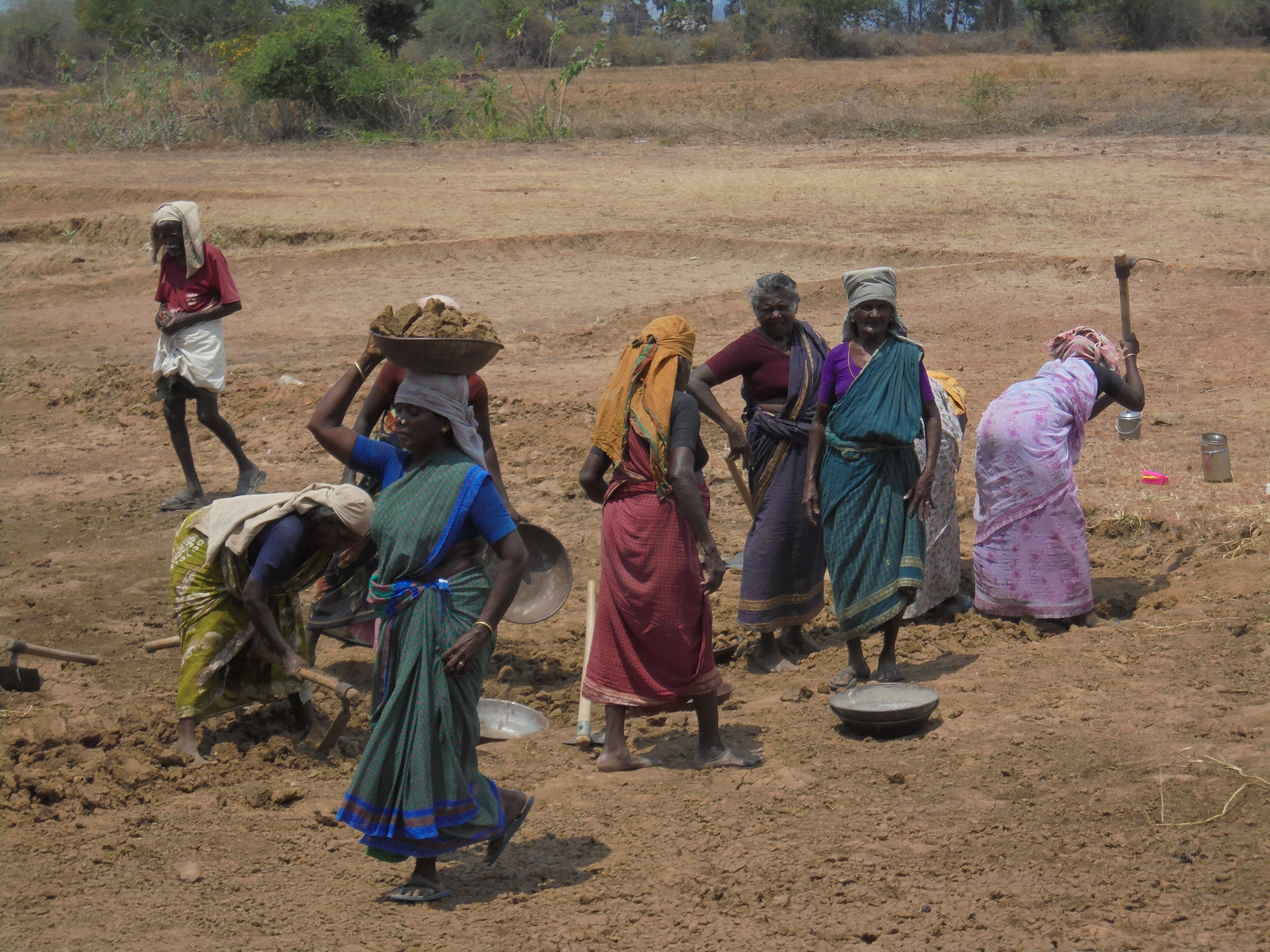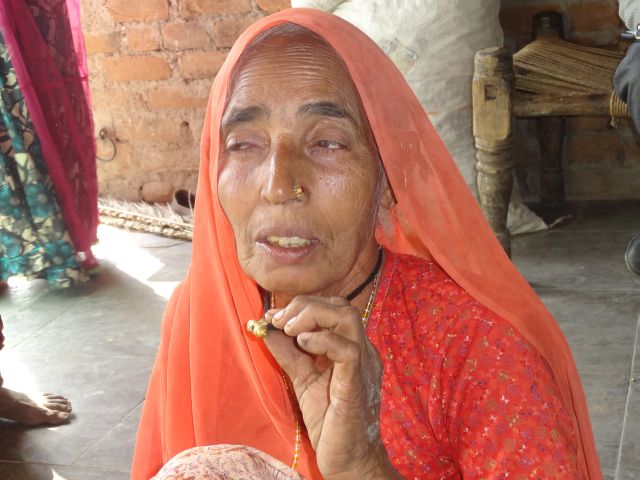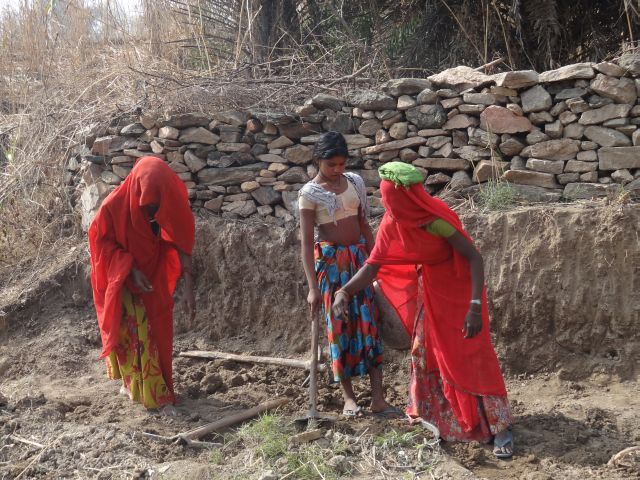
When Satya was asked by the Sarpanch to opt for the position of a worksite supervisor as a Mate, she was thrilled at the prospect of a better life. Brought up in Murayur village in Sivagangai district, Tamil Nadu, she knew how tough agricultural wage labour work was. While her mother left her with grandparents, her father also took on menial jobs and errands from big farmers. This helped them pay off family debt that had mounted over the years as well as support Satya's schooling.
When her parents opted for job cards for labour work under the employment guarantee programme -- Mahatma Gandhi National Rural Employment Guarantee Programme (MGNREGA) -- Satya was disinclined. The labour intensive ‘lift-and-carry’ work done by women under the blazing summer sun was very hard. Soon, she found a way out. Satya was trained as a Mate, a supervisory role under MGNREGA.
The MGNREGA Act and water works
The MGNREGA Act guarantees each household at least 100 days of employment in a year. While all adults in rural households can take up unskilled manual work, the Act guarantees that a third of those employed are women, and equal pay is provided at the statutory minimum wage rate.
'80% of the works taken up under NREGA involved natural resources such as surface and groundwater, crop lands, soil and wastelands. Efforts at water conservation, drought proofing, and renovation of traditional water bodies have contributed to improved groundwater levels, increased water availability for irrigation, and increase in irrigated land' (1).
Over the country, the MGNREGA programme has led to high women’s work participation rates. In states like Tamil Nadu, women constitute more than 80 percent of MGNREGA workers. In fact, in Satya’s worksite at Sivagangai there are no men.
Fortunately, Satya did not have to fight against odds to be a worksite supervisor. She sums it up simply. "Not many men in the village were inclined towards the job. The male market wage rate for unskilled labour in the area was Rs. 400, way above the Rs. 167 a day that a Mate gets". It is obvious that the ratio of men and women on worksites would change if wages offered under MGNREGA were higher.
Training and building capacities
Immediately after her selection, Satya underwent training at Sivagangai that built
'capacities' of rural women to perform the role. This helped her perform the required technical and supervisory tasks such as measuring work, assigning work to labourers in small groups and supervising. Unlike women Mates in some States, Satya does not face exclusion and gets MGNREGA works from the Gram Panchayat. In Rajasthan, for example, the few women who make it to this position after facing a lot of opposition from men struggle to stay there because of societal pressures.
perform the role. This helped her perform the required technical and supervisory tasks such as measuring work, assigning work to labourers in small groups and supervising. Unlike women Mates in some States, Satya does not face exclusion and gets MGNREGA works from the Gram Panchayat. In Rajasthan, for example, the few women who make it to this position after facing a lot of opposition from men struggle to stay there because of societal pressures.
Satya mostly handles work related to the renovation of water harvesting systems locally known as tanks. She looks like an effective worksite supervisor as she struggles with the muster roll at her worksite. She ensures that the muster roll is filled properly and that women get their share of entitlements like work shelters, drinking water etc., assured under the 'wage for work' programme. She also encourages women in her village to demand work under the programme. The presence of male contractors posed a barrier to women earlier but with more women supervisors/ mates like herself, the participation of women in MGNREGA has increased. Most women in her village feel that MGNREGA was indispensable for their livelihoods.
Is MGNREGA gender inclusive in practice?
While Satya typifies the lives and aspirations of a large number of women in the country, have women been successful in negotiating fair wages? Has feminisation of the labour force under the MGNREGA programmes enabled women to get rights? Do they face complaints that women are weak, do not work fast enough and that this compromises the work quality? Has it not intensified womens' work without much of a change in men’s role?
While there aren't clear answers to these questions, we find the following when we look at MGNREGA from the standpoint of women:
- Women do get attracted to the wage rate as minimum wage rate is assured. In most States, this is higher than the prevailing market wage rates for unskilled women workers. Many women prefer MGNREGA work as it is closer home, which lets them manage childcare and other household responsibilities better. Temporary crèches are available at most worksites in the form of ‘jhulas’ for managing infants.
 Among women, there are considerable variations. Single women headed households who constitute the poorest households prefer daily wage payments to MGNREGA work. This is because of the uncertainty and delays regarding payment. At times, delays could be over a year.
Among women, there are considerable variations. Single women headed households who constitute the poorest households prefer daily wage payments to MGNREGA work. This is because of the uncertainty and delays regarding payment. At times, delays could be over a year. - Where both men and women from the household go for wage work, men allocate time to non-MGNREGA work given the male‐female disparity in market wages. Women on the other hand go for MGNREGA work. This explains the lopsided ratio of women to men in MGNREGA worksites. If we look at the work force in general, the situation is drastically different and men outnumber women.
- In worksites which have equal number of men and women, the men usually do tasks like digging while women do ‘lift and carry’ work. In 'all-women' worksites, the pressure on women is higher as they have to do the digging as well.
- Among many communities, there was insensitivity about the nature of work offered to elderly women from the point of view of their health. The need for wage labour brought them to the worksite, but more thought needs to go into the fixation with linking earning to effort and productivity given the inability of women at various points of time to undertake hard manual labour.
- Household well being had improved but no changes were observed in the allocation of household responsibilities following women’s involvement in MGNREGA.
- One takeaway for women is that since the program allows them to work on their own farms to develop land and water-related assets, th
 ey are paid for it. This used to go unpaid earlier being a part of family labour.
ey are paid for it. This used to go unpaid earlier being a part of family labour. - Most of the decisions related to workplan regarding MGNREGA are taken at the panchayat level. In Rajasthan, it was observed that women, including those from women headed households, were absent in panchayat meetings. Awareness about the MGNREGA programme and its auditing was low and women were largely in use as passive labour. This, even where civil society organizations were active, and were enabling panchayats for providing information, registering workers, supervising works and payment.
The macro picture
The 68th round National Sample Survey Organisation (NSSO) report of 2011 indicates that the participation of women in the rural labour force was declining (25% in 2004-05 to 21% in 2009-10 and then even lower to around 17% in 2011-12). Does this mean that MGNREGA has pushed women out from the rest of the rural labour force?
The chart on the percentage of women demanding MGNREGA work year-wise bears out that women form an unduly large chunk of MGNREGA persondays when compared to their proportion in the rural labour force.
According to the GameChanger Perspectives report, ‘women are increasingly being priced out of the agricultural labour market and are taking shelter in NREGA work schemes.’ The upward pressure on female wages with the government guaranteeing work under MGNREGA, has led to farm owners preferring men over women for the same works.
This has led to a situation where women have preferred MGNREGA and now that that they have been priced out of the general rural labour force, have no other option left other than MGNREGA.
Is it a good sign? Not really, as the program is largely non-skill based. It needs to be tailored to increase the productivity and skillsets of people.
The way ahead
Right now, the work entitlements for MGNREGA are household-based and not individual. It is high time that both men and women, and not households be entitled to guaranteed employment.
All said and done, MGNREGA has done pretty well and offers many opportunities for rural women, especially in a situation where women are being alienated from the rural work force. In all, the programme needs to be strengthened and pathways created for more productive public works.
References
(1) Study sees NREGA potential in conserving natural resources
(2) Ratna M. Sudarshan, Women’s participation in the NREGA: the interplay between wage work and care, For Chronic Poverty Research Centre (CPRC) Conference, Manchester, UK, 5 – 11 September 2010
(3) Narayanan, S and U Das (2014), “Women Participation and Rationing in the Employment Guarantee Scheme”, Economic and Political Weekly, 49(46): 46-53.
(4) Sudarshan, RM (2011), ‘India’s National Rural Employment Guarantee Act: Women’s Participation and Impacts in Himachal Pradesh, Kerala and Rajasthan’, Research Report Summary 06, Institute of Development Studies
(6) Drèze, J and C Oldiges (2007), ‘How is NREGA Doing’.
/articles/women-assert-their-space-under-sun